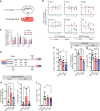Characterization of More Selective Central Nervous System Nrf2-Activating Novel Vinyl Sulfoximine Compounds Compared to Dimethyl Fumarate
- PMID: 32394330
- PMCID: PMC7609514
- DOI: 10.1007/s13311-020-00855-0
Characterization of More Selective Central Nervous System Nrf2-Activating Novel Vinyl Sulfoximine Compounds Compared to Dimethyl Fumarate
Abstract
The Nrf2 transcription factor is a key regulator of redox reactions and considered the main target for the multiple sclerosis (MS) drug dimethyl fumarate (DMF). However, exploration of additional Nrf2-activating compounds is motivated, since DMF displays significant off-target effects and has a relatively poor penetrance to the central nervous system (CNS). We de novo synthesized eight vinyl sulfone and sulfoximine compounds (CH-1-CH-8) and evaluated their capacity to activate the transcription factors Nrf2, NFκB, and HIF1 in comparison with DMF using the pTRAF platform. The novel sulfoximine CH-3 was the most promising candidate and selected for further comparison in vivo and later an experimental model for traumatic brain injury (TBI). CH-3 and DMF displayed comparable capacity to activate Nrf2 and downstream transcripts in vitro, but with less off-target effects on HIF1 from CH-3. This was verified in cultured microglia and oligodendrocytes (OLs) and subsequently in vivo in rats. Following TBI, DMF lowered the number of leukocytes in blood and also decreased axonal degeneration. CH-3 preserved or increased the number of pre-myelinating OL. While both CH-3 and DMF activated Nrf2, CH-3 showed less off-target effects and displayed more selective OL associated effects. Further studies with Nrf2-acting compounds are promising candidates to explore potential myelin protective or regenerative effects in demyelinating disorders.
Keywords: HIF; NFκB; Nrf2; dimethyl fumarate; microglia; multiple sclerosis; pTRAF; redox regulation; traumatic brain injury; sulfoximine.
Conflict of interest statement
The authors declare that they have no conflict of interest.
Figures




References
-
- Copple IM. The Keap1-Nrf2 cell defense pathway--a promising therapeutic target? Adv Pharmacol. 2012;63:43–79. - PubMed
-
- Krämer T, Grob T, Menzel L, Hirnet T, Griemert E, Radyushkin K, et al. Dimethyl fumarate treatment after traumatic brain injury prevents depletion of antioxidative brain glutathione and confers neuroprotection. J Neurochem. 2017;143(5):523–33. - PubMed
Publication types
MeSH terms
Substances
LinkOut - more resources
Full Text Sources
Other Literature Sources

